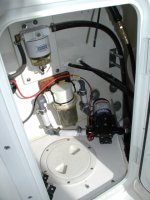I have a pair of racor filter separator does anyone know where to get a manual for it? Can't seem to find anything on the web except where to buy one.
I need to replace the spin off filters and not sure what will happen when I spin it off is there a check valve that will stop fuel flow? Does the plastic on the bottom spin off as well? Do I need to fill it before use? thanks michael
I need to replace the spin off filters and not sure what will happen when I spin it off is there a check valve that will stop fuel flow? Does the plastic on the bottom spin off as well? Do I need to fill it before use? thanks michael


